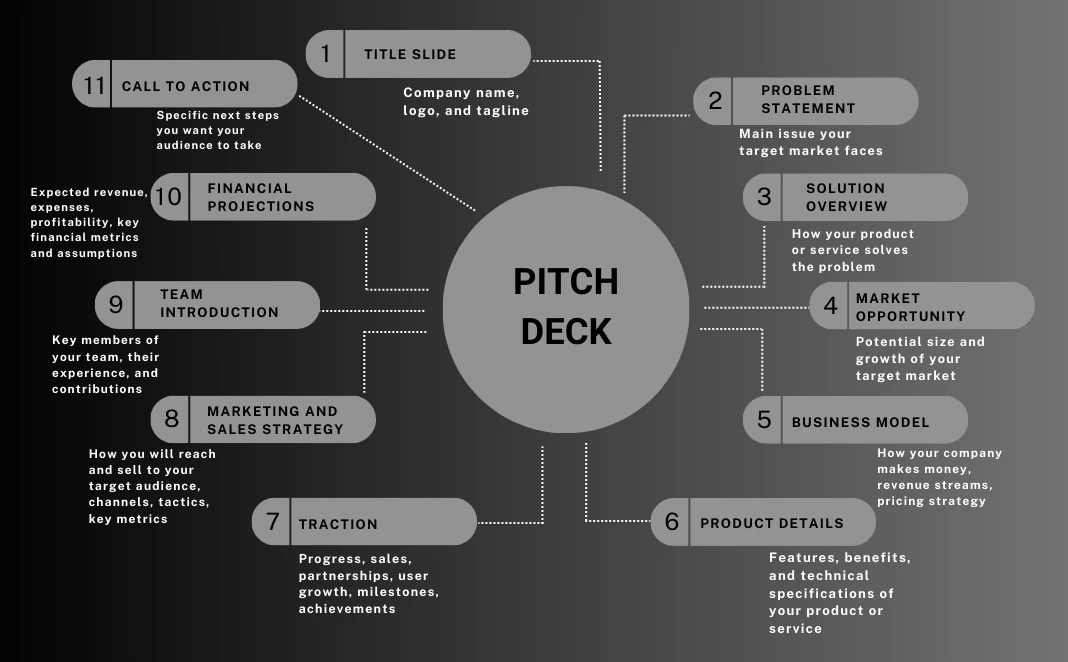)
Are you struggling to create a pitch that grabs investors' attention? You need a strong, clear business pitch (pitch deck) to stand out. Creating a compelling business pitch is crucial for securing investment, partnerships, or clients. In this business pitch deck guide, we'll simplify the process for you. Here, we will explore the fundamentals of developing an effective business pitch, including definitions, examples, and strategies. By the end, you'll have a comprehensive understanding of how to craft a pitch deck that stands out and achieves its purpose.
Business Pitch Definition
A business pitch or a pitch deck is a short, persuasive presentation about your business idea. It aims to attract potential investors, clients, or partners. The business pitch definition includes outlining your value proposition and market opportunity. It refers to a concise, visual presentation of your business concept, highlighting your key points in an engaging, easy-to-understand format.
Pitch Meaning in Business
A successful pitch in business highlights the unique value and potential benefits. It often includes a clear problem, solution, and market opportunity. Business owners practice their pitch to deliver it confidently and clearly. A strong pitch in business can lead to funding, partnerships, or sales.
Purpose of a pitch deck
The pitch deck purpose is to provide a visual summary of your business idea. It helps potential investors quickly understand your concept. The pitch deck includes highlighting your product, market, and business model. It aims to generate interest and excitement about your business. By clearly presenting key points, it helps secure follow-up meetings. The pitch deck's purpose is to make a strong first impression and encourage further discussion as well. Additionally, a well-crafted pitch deck can complement a business proposal, providing a compelling narrative to support funding requests and strategic partnerships.
Business Pitch Presentation
A successful business pitch presentation needs clarity, engagement, and visual appeal. Clear communication ensures your audience understands your message quickly. Engage your audience with a compelling story and strong visuals. Use high-quality images to make your business pitch presentation more attractive. Bullet points help organize information and keep your text concise. Each slide in your business pitch presentation should focus on one main idea. Avoid clutter and keep your design clean and professional. Practicing your delivery will make your business pitch presentation more confident and effective.
Pitch Deck Structure
A pitch deck structure helps organize and present your ideas clearly. Each section has a specific purpose and content.
Title Slide: The title slide introduces your business with the company name, logo, and tagline.
Problem Statement: The problem statement highlights the main issue your target market faces. Explain why this problem needs solving.
Solution Overview: The solution overview describes how your product or service solves the problem. Focus on the unique benefits and features.
Market Opportunity: Market opportunity shows the potential size and growth of your target market. Use data to support your claims.
Business Model: The business model explains how your company makes money. Describe your revenue streams and pricing strategy.
Product Details: Product details provide more information about your product or service. Include features, benefits, and any technical specifications.
Traction: Traction shows any progress you have made, like sales, partnerships, or user growth. Highlight key milestones and achievements.
Marketing and Sales Strategy: Marketing and sales strategy outlines how you will reach and sell to your target audience. Include channels, tactics, and key metrics.
Team Introduction: Team introduction presents the key members of your team. Highlight their experience and how they contribute to the business.
Financial Projections: Financial projections show your expected revenue, expenses, and profitability. Include key financial metrics and assumptions.
Call to Action: The call to action tells your audience what you want them to do next. Be clear and specific about your ask.

Pitch Deck Steps
Creating a pitch deck involves several important steps. Follow these steps to make a compelling presentation.
Research: Research to understand your audience. Know their interests, needs, and preferences.
Outline: Outline your content. Plan the key points for each section of your pitch deck.
Design: Design visually appealing slides. Use high-quality images, clear fonts, and consistent colors.
Practice: Practice your presentation. Rehearse to ensure you deliver your message confidently and clearly.
Feedback: Get feedback from others. Refine your pitch deck based on their input to improve it further.
By following these steps, you can create an effective and engaging pitch deck.
Business Pitch Examples
Famous business pitch examples include Airbnb, Facebook, and Uber. These business pitch examples are successful because they clearly present their value propositions. Airbnb's pitch deck explains the problem, solution, and market opportunity effectively. Facebook's pitch deck highlights user growth and engagement. Uber's pitch deck showcases a clear business model and market potential. These business pitch examples use simple, visually appealing slides. They focus on key points and use data to support their claims. Analyzing these business pitch examples can provide valuable insights for your own pitch.
Practical Business Pitch Ideas
Creating a compelling business pitch involves several key elements. Here are some practical business pitch ideas:
Unique Value Proposition: Clearly explain what sets your product or service apart. Focus on the unique benefits you offer.
Real-Life Examples: Use real-life examples to illustrate your points. Show how your product or service has solved problems for others.
Testimonials: Include testimonials from satisfied customers. These add credibility and show real-world success.
Clear Problem Statement: Define the problem your business addresses. Make it relatable and easy to understand.
Engaging Story: Tell a compelling story that captures attention. Connect emotionally with your audience.
Data and Metrics: Use data to back up your claims. Show market potential, growth, and financial projections.
Visual Appeal: Make your slides visually appealing. Use high-quality images, consistent fonts, and clean design.
By incorporating these business pitch ideas, you can create a more persuasive and memorable presentation.
Difference Between Business Pitch and Business Plan
A business pitch and a business plan serve different purposes. A business pitch is a short presentation aimed at selling an idea quickly. It focuses on capturing interest and securing follow-up meetings. A business pitch highlights key points like the problem, solution, and market opportunity.
A business plan is a more structured and detailed document that outlines your business strategy. It includes sections on strategic planning, financial projections, and business valuation. The business plan serves as a roadmap for your business, guiding long-term decisions.
The purpose of a business pitch is to generate immediate interest. The purpose of a business plan is to provide a comprehensive guide for running the business. Investors use the business pitch to decide if they want to learn more. They use the business plan to understand the business in-depth and assess its viability.
In summary, a business pitch is for quick, impactful presentations. A business plan is for detailed strategic planning and business valuation.
Both are essential, but they serve different roles in the business process.
Conclusion
In this blog, we covered the meaning and purpose of a business pitch. We discussed creating an effective pitch deck, outlined the steps for creating a pitch deck, and what to include in each section. We also explained the difference between a business pitch and a business plan. Additionally, we provided famous business pitch examples and offered practical business pitch ideas.
Use these tips to craft a compelling business pitch. Start by researching your audience, outlining your content, designing appealing slides, and practicing your delivery. Review famous business pitch examples for inspiration.
For the creation of a business plan, you can trust PrometAI. PrometAI's AI Business Plan Generator can create a competitive business plan for your business. Present your ideas with confidence and attract the support you need.
FAQs
1. What Do You Say in a Business Pitch?
In a business pitch, introduce your business, state the problem, and present your solution. Highlight market opportunity, explain your business model, and share traction. Outline your marketing strategy, introduce your team, provide financial projections, and end with a clear call to action.
2. How to Start a Business Pitch?
Start with a strong hook that grabs attention. This could be an intriguing fact, a compelling story, or a bold statement about your business’s potential.
3. What is the Purpose of a Pitch Deck?
The purpose of a pitch deck is similar to an elevator pitch: to tell a compelling story and grab the attention of potential investors, partners, or clients.
4. How Long Should a Pitch Deck Be?
A pitch deck should be concise, ideally 10 to 20 slides, to maintain the audience's interest and deliver the core message effectively.
5. Why is it Called a Pitch Deck?
The term "pitch deck" originates from the idea of a "deck" of cards. Each slide represents a card in the deck, collectively telling a story about your business.
6. Is a Pitch Deck Just a PowerPoint?
Yes, a pitch deck is typically a PowerPoint or similar presentation format, but it must be well-designed to convey the key aspects of your business succinctly.
7. What is the Main Purpose of Developing a Business Pitch?
The primary purpose of developing a business pitch is to clearly and concisely present your business idea, value proposition, and market opportunity.
8. What are Pitch Deck Steps?
Creating a pitch deck involves several important steps: research, outline, design, practice, and feedback.
9. What Should a Pitch Deck Include?
Pitch Deck generally should Include: the problem, solution, market opportunity, business model, product details, traction, marketing strategy, team, financials, and call to action.
